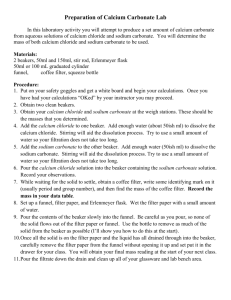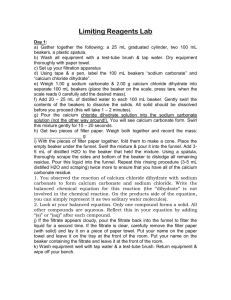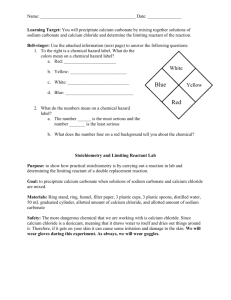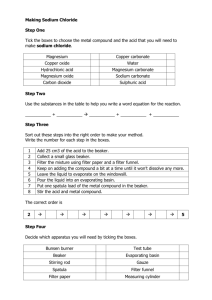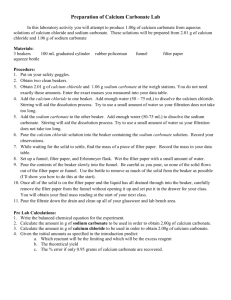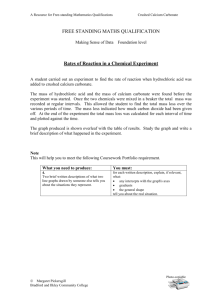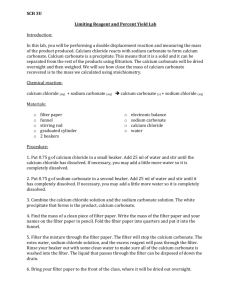Stoichiometry and Limiting Reactant
advertisement
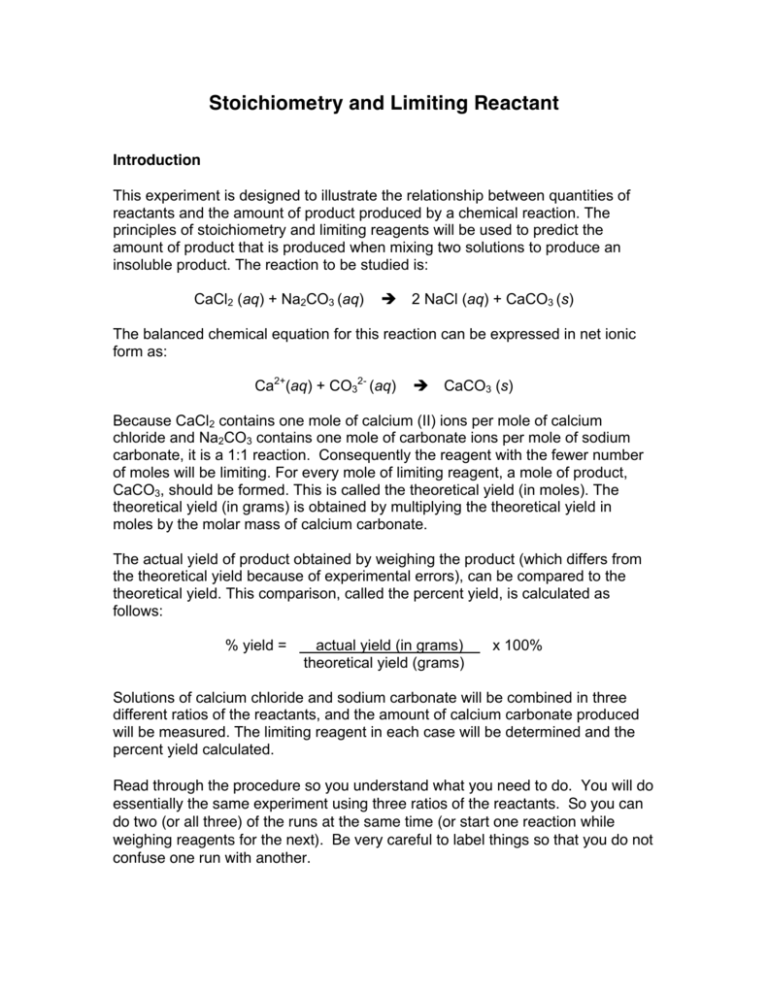
Stoichiometry and Limiting Reactant Introduction This experiment is designed to illustrate the relationship between quantities of reactants and the amount of product produced by a chemical reaction. The principles of stoichiometry and limiting reagents will be used to predict the amount of product that is produced when mixing two solutions to produce an insoluble product. The reaction to be studied is: CaCl2 (aq) + Na2CO3 (aq) 2 NaCl (aq) + CaCO3 (s) The balanced chemical equation for this reaction can be expressed in net ionic form as: Ca2+(aq) + CO32- (aq) CaCO3 (s) Because CaCl2 contains one mole of calcium (II) ions per mole of calcium chloride and Na2CO3 contains one mole of carbonate ions per mole of sodium carbonate, it is a 1:1 reaction. Consequently the reagent with the fewer number of moles will be limiting. For every mole of limiting reagent, a mole of product, CaCO3, should be formed. This is called the theoretical yield (in moles). The theoretical yield (in grams) is obtained by multiplying the theoretical yield in moles by the molar mass of calcium carbonate. The actual yield of product obtained by weighing the product (which differs from the theoretical yield because of experimental errors), can be compared to the theoretical yield. This comparison, called the percent yield, is calculated as follows: % yield = actual yield (in grams) theoretical yield (grams) x 100% Solutions of calcium chloride and sodium carbonate will be combined in three different ratios of the reactants, and the amount of calcium carbonate produced will be measured. The limiting reagent in each case will be determined and the percent yield calculated. Read through the procedure so you understand what you need to do. You will do essentially the same experiment using three ratios of the reactants. So you can do two (or all three) of the runs at the same time (or start one reaction while weighing reagents for the next). Be very careful to label things so that you do not confuse one run with another. Experimental Methods and Materials. In the following instructions, “calcium chloride” and “sodium carbonate” are used generically for these salts, regardless of their state of hydration (whether water is included in the crystal matrix). Read the labels carefully to determine the specific form of the salt you use and its formula weight, and be sure to include this information in your notes. The water of hydration does change the formula weight you will use in your stoichiometric and yield calculations. The weights given here are approximate. The weights of your reagents should be +/- 0.1 g from those given. Record all your exact weights to the nearest milligram. This experiment can be done using just the standard glassware from the lockers. Procedure. l) Put 1.00 grams of calcium chloride in a small beaker. Add 25 ml of water and stir until the calcium chloride has dissolved. If necessary you may add a little more water so it dissolves completely. 2) Put 1.00 grams of sodium carbonate in a second beaker. Add 25 ml of water and stir until it has completely dissolved. If necessary you may add a little more water so it dissolves completely. 3) Combine the calcium chloride and the sodium carbonate solutions. The white precipitate that forms is the product calcium carbonate. You may need to wait several minutes for the precipitate to coagulate sufficiently to filter well. 4) Find the mass of a clean piece of filter paper. Write the mass of the filter paper, a group identifier, and trial number on the filter paper in pencil. Fold the filter into quarters and put it into the funnel. Wet the filter with deionized water, and let it drain. 5) Pour the calcium carbonate mixture through the filter paper. The filter will stop the calcium carbonate. The extra water, dissolved sodium chloride, and excess reactants will pass through the filter. Save this first filtrate. Rinse your beaker out with some cold deionized water to make sure all of the calcium carbonate is washed into the filter. Rinse the filter itself with a small amount of cold water to remove any sodium chloride from the filter. 6) Store your filter paper on a watch glass or in a beaker. Place it as directed so it can dry out. Depending on time, we may use the drying oven or allow the papers to “air-dry” over the weekend. 7) Divide the first filtrate into two portions in medium-size test tubes. Treat one portion with a few milliliters of potassium hydrogen phosphate (K2HPO4) solution, and note any changes. Calcium phosphate (Ca3(PO4)2) will form a precipitate if there is Ca+2 present in the filtrate. Test the pH of the other solution with a pHydrion strip and note the results. The solution should be mildly basic if there is carbonate ion present. 8) Repeat steps 1-7 with 0.75 g of calcium chloride and 1.25 g of sodium carbonate. 9) Repeat steps 1-7 with 1.25 g of calcium chloride and 0.75 g of sodium carbonate. 10) All leftover liquids from the experiment can be disposed of down the drain. Clean your glassware before any solid has a chance to dry. Data and Calculations This experiment is the subject of a formal lab report. So you need to have all the information in your notebook to write up the report. For purposes of the report, your data can be summarized in a table such as that below. Note that the “raw” data (the actual weights recorded at the balance) are not shown, only the data that was subsequently used in calculations or in drawing conclusions. Your table can be set up differently, or you might use more than one table. Your table should be built in Excel (or equivalent spreadsheet) and exported to your text document. Your report should show one example of each calculation. So you would work through the calculation to predict the mass of CaCO3 and % yield for one trial. What other calculation (related to this) would you show? Trial Mass of CaCl2 Mass of Na2CO3 Mass of CaCO3 Predicted Mass of CaCO3 % Yield Predicted Excess Limiting Reagent Reagent Found 1 2 3 Results and Discussion In this section, you briefly describe your results and their significance. For example, you might comment that although all three of your trials used a total of ~ 2.0 grams of reactants, one combination gave the most product. Why was this ratio better than the others? You should also comment on experimental difficulties and how these might affect your results. For example, what would be the effect on your yield if you did not wash all of the calcium carbonate from the beaker (step 5); or what would be the effect on the yield of your filter paper were not completely dry (step 6). Hint: There is one part of the experiment that has not been tested in class. I expect that those results may be hard to interpret. So you should be critical of your data and observations, but donʼt “over-interpret” just to find something to write about. Conclusion In one or two sentences, what was the purpose of the experiment (recapitulation of the Introduction), and did your experiment fulfill that purpose (did you learn what you expected?). Wasnʼt that fun?


